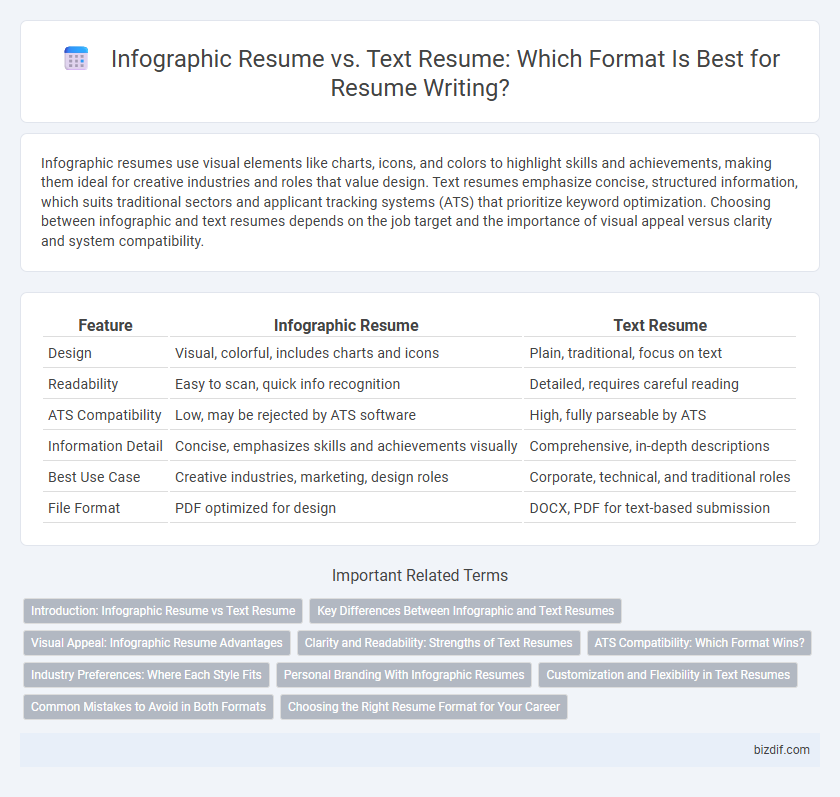Infographic resumes use visual elements like charts, icons, and colors to highlight skills and achievements, making them ideal for creative industries and roles that value design. Text resumes emphasize concise, structured information, which suits traditional sectors and applicant tracking systems (ATS) that prioritize keyword optimization. Choosing between infographic and text resumes depends on the job target and the importance of visual appeal versus clarity and system compatibility.
Table of Comparison
| Feature | Infographic Resume | Text Resume |
|---|---|---|
| Design | Visual, colorful, includes charts and icons | Plain, traditional, focus on text |
| Readability | Easy to scan, quick info recognition | Detailed, requires careful reading |
| ATS Compatibility | Low, may be rejected by ATS software | High, fully parseable by ATS |
| Information Detail | Concise, emphasizes skills and achievements visually | Comprehensive, in-depth descriptions |
| Best Use Case | Creative industries, marketing, design roles | Corporate, technical, and traditional roles |
| File Format | PDF optimized for design | DOCX, PDF for text-based submission |
Introduction: Infographic Resume vs Text Resume
Infographic resumes use visual elements like charts and icons to highlight skills and achievements, making them ideal for creative industries and roles requiring design expertise. Text resumes provide detailed, structured information suited for traditional fields that emphasize clarity and keyword optimization for applicant tracking systems (ATS). Choosing between infographic and text resumes depends on the job context, target audience, and the need to balance visual appeal with content accessibility.
Key Differences Between Infographic and Text Resumes
Infographic resumes utilize visual elements like icons, charts, and color schemes to present skills and experience, enhancing immediate readability and engagement, whereas text resumes follow a traditional format emphasizing clear, linear information with concise bullet points. Infographic resumes often appeal to creative industries seeking innovation, while text resumes remain preferred in formal sectors prioritizing straightforward data parsing. The key difference lies in presentation style and suitability for diverse job markets, impacting applicant tracking system compatibility and recruiter preferences.
Visual Appeal: Infographic Resume Advantages
Infographic resumes leverage vibrant colors, icons, and charts to convey professional information quickly, enhancing visual engagement and retention. Their visually structured format highlights key skills and achievements, making it easier for hiring managers to scan and comprehend qualifications. This design-driven approach often results in a stronger first impression compared to traditional text-heavy resumes.
Clarity and Readability: Strengths of Text Resumes
Text resumes offer superior clarity and readability due to their straightforward format, making key information easy to locate for recruiters. The linear structure supports quick scanning and consistent presentation of skills, experience, and education. Text resumes are also compatible with applicant tracking systems (ATS), ensuring better chances of passing automated screenings.
ATS Compatibility: Which Format Wins?
Text resumes outperform infographic resumes in ATS compatibility, as applicant tracking systems primarily parse plain text to extract relevant keywords and qualifications. Infographic resumes with complex graphics, charts, and unconventional layouts often confuse ATS algorithms, risking omitted or misread information. For maximizing chances in automated screenings, a clean, text-based format remains the optimal choice.
Industry Preferences: Where Each Style Fits
Infographic resumes excel in creative industries like marketing, design, and media where visual storytelling highlights skills and achievements effectively. Text resumes remain preferred in traditional sectors such as finance, law, and healthcare where clarity, formality, and keyword optimization for ATS (Applicant Tracking Systems) ensure better screening. Choosing the appropriate resume style hinges on the industry's emphasis on visual impact versus structured, detailed information presentation.
Personal Branding With Infographic Resumes
Infographic resumes enhance personal branding by visually highlighting key skills, achievements, and experiences, making candidates stand out in competitive job markets. Incorporating charts, icons, and creative layouts communicates information quickly and memorably, appealing to employers seeking innovative and detail-oriented professionals. While text resumes focus on comprehensive details, infographic resumes prioritize impact and engagement, reinforcing a candidate's unique professional identity.
Customization and Flexibility in Text Resumes
Text resumes offer greater customization and flexibility compared to infographic resumes, allowing candidates to tailor content specifically for different job applications by adjusting keywords and formatting easily. Recruiters often prefer text resumes due to their compatibility with applicant tracking systems (ATS), which may not accurately parse infographic elements. This flexibility ensures that critical information is clear and prioritized, enhancing the chances of passing automated screening processes.
Common Mistakes to Avoid in Both Formats
Common mistakes to avoid in both infographic and text resumes include cluttered design that overwhelms the reader, inconsistent formatting that reduces readability, and vague or generic language that fails to highlight specific achievements. Use clear headers, concise bullet points, and quantifiable metrics to effectively communicate your skills and experience. Ensuring balance between visual appeal and content clarity is crucial to capture recruiters' attention without sacrificing professionalism.
Choosing the Right Resume Format for Your Career
Selecting the right resume format depends on your industry and career goals; infographic resumes are ideal for creative fields like graphic design or marketing, showcasing skills visually to capture attention. Text resumes remain preferred in traditional sectors such as finance or law, emphasizing clear, straightforward presentation of experience and qualifications. Tailoring your resume format to align with employer expectations and job requirements maximizes your chances of making a strong impact.
Infographic Resume vs Text Resume Infographic

 bizdif.com
bizdif.com